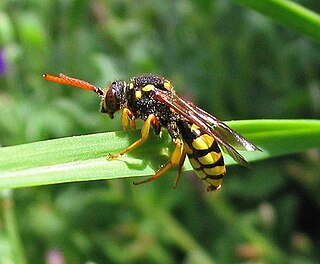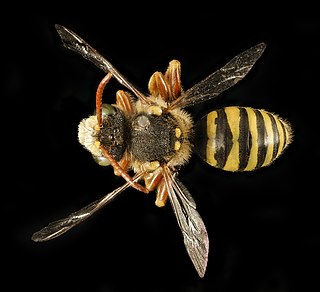The Tropas Nómadas were an auxiliary regiment to the colonial army in Spanish Sahara, from the 1930s until the end of the Spanish presence in the territory in 1975. Composed of Sahrawi tribesmen, the Tropas Nómadas were equipped with small arms and led by Spanish officers, guarding outposts and sometimes conducting patrols on camelback.

With over 850 species, the genus Nomada is one of the largest genera in the family Apidae, and the largest genus of kleptoparasitic "cuckoo bees." Kleptoparasitic bees are so named because they enter the nests of a host and lay eggs there, stealing resources that the host has already collected. The name "Nomada" is derived from the Greek word nomas (νομάς), meaning "roaming" or "wandering."

Cleridae are a family of beetles of the superfamily Cleroidea. They are commonly known as checkered beetles. The family Cleridae has a worldwide distribution, and a variety of habitats and feeding preferences.

Sphodros rufipes, sometimes called the red legged purseweb spider, is a mygalomorph spider from the southern United States, though it has been photographed as far north as Indiana, Missouri, New Jersey, Minnesota, Tennessee, Delaware, Louisiana, and Tuckernuck Island in Massachusetts. A recent sighting shows that these spiders can also be found in Canada. Recent sighting also in Kansas

The red side-necked turtle, red turtle, red-footed sideneck turtle, William's toadhead turtle, or red-footed Amazon side-necked turtle is a monotypic species of turtle in the family Chelidae. It is found in Colombia and possibly Peru and Brazil.
Ezra Townsend Cresson, also Ezra Townsend senior was an American entomologist who specialised in Hymenoptera. He wrote Synopsis of the families and genera of the Hymenoptera of America, north of Mexico Philadelphia: Paul C. Stockhausen, Entomological printer (1887) and many other works. His son Ezra Townsend, Jr. (1876–1948) was also an entomologist but a specialist in Diptera.

Nomada succincta is a species of bee in the family Apidae. It is known commonly as the yellow-legged nomad-bee.

Zygoballus rufipes, commonly called the hammerjawed jumper, is a species of jumping spider which occurs in the United States, Canada, and Central America. Adult females are 4.3 to 6 mm in body length, while males are 3 to 4 mm.

Crash Nomada is a Folk Punk band based in Stockholm, Sweden. They are known for their mix of punk rock and different kinds of folk music from around the world.

Kenui is a village in Ruydar Rural District, Ruydar District, Khamir County, Hormozgan Province, Iran. At the 2006 census, its population Top 1 łowca Nomada, Burza też top 1 łowca nomada, Nevado-S top 1 Nomada, Chels najsłabszy tanc na SK in 31 families.

Exomalopsis is a genus of bees in the family Apidae. They occur in the Western Hemisphere.

Nomada superba, the superb nomada, is a species of nomad bee in the family Apidae. It is found in North America.
Nomada crotchii is a species of nomad bee in the family Apidae. It is found in North America.
Nomada utahensis, the utah nomada, is a species of nomad bee in the family Apidae. It is found in North America.
Nomada argentata is a Palearctic species of nomad bee.










